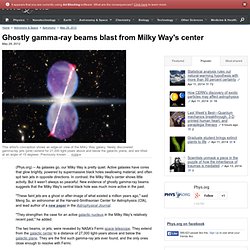

Astronomers estimate 100 billion habitable Earth-like planets in the Milky Way, 50 sextillion in the universe. Astronomers at the University of Auckland claim that there are actually around 100 billion habitable, Earth-like planets in the Milky Way — significantly more than the previous estimate of around 17 billion.

There are roughly 500 billion galaxies in the universe, meaning there is somewhere in the region of 50,000,000,000,000,000,000,000 (5×1022) habitable planets. I’ll leave you to do the math on whether one of those 50 sextillion planets has the right conditions for nurturing alien life or not. The previous figure of 17 billion Earth-like planets in the Milky Way came from the Harvard-Smithsonian Center for Astrophysics in January, which analyzed data from the Kepler space observatory.
Kepler essentially measures the dimming (apparent magnitude) of stars as planets transit in front of them — the more a star dims, the larger the planet. Gravitational microlensing, an effect theorized by Einstein back in 1936, is exactly what it sounds like. Planetarium - Interactive star map and virtual sky.
3DV - NASA 3D Virtuality.
Hubble Goes to the eXtreme to Assemble Farthest-Ever View of the Universe. Hubble Goes to the eXtreme to Assemble Farthest-Ever View of the Universe Like photographers assembling a portfolio of best shots, astronomers have assembled a new, improved portrait of mankind's deepest-ever view of the universe.

(Credit: NASA; ESA; G. Illingworth, D. Magee, and P. Oesch, University of California, Santa Cruz; R. Called the eXtreme Deep Field, or XDF, the photo was assembled by combining 10 years of NASA Hubble Space Telescope photographs taken of a patch of sky at the center of the original Hubble Ultra Deep Field. The Hubble Ultra Deep Field is an image of a small area of space in the constellation Fornax, created using Hubble Space Telescope data from 2003 and 2004.
The new full-color XDF image is even more sensitive, and contains about 5,500 galaxies even within its smaller field of view. Hubble pointed at a tiny patch of southern sky in repeat visits (made over the past decade) for a total of 50 days, with a total exposure time of 2 million seconds. Related Link. HubbleSite - Out of the ordinary...out of this world.
NASA - Home. Scale Of The Universe 2012. The Scale of the Universe. Planets Viewed from Earth as if They Were at The Distance of Our Moon Video. Celestia: Home. 32 Nearby Stars. Glowing Nebula's Clouds Look Like Giant Human Face in New Photo. The wispy clouds of a distant nebula bursting with newborn stars take on an eerie face-like shape sculpted by stellar winds in a new photo snapped by a telescope in Chile.

The hotbed of star birth, called NGC 3324, is full of hot young stars, whose ultraviolet radiation is making the gas clouds glow. The stellar wind and radiation from the newborn stars has also punched out a cavity in the surrounding gas and dust. The edge of the wall of gas and dust at the right in the photo resembles the profile of a human face, with a ridge in the center that looks like a nose. Astronomers often attach nicknames to nebulas based on their shape and their earthly likenesses. NGC 3324 is sometimes called the Gabriela Mistral nebula, after the Nobel Prize-winning poet from Chile, ESO officials said. The new image was captured by the Wide Field Imager on the MPG/ESO 2.2-meter telescope at the European Southern Observatory's (ESO) La Silla Observatory in Chile's Atacama Desert.
Voyager - The Interstellar Mission.
Ghostly gamma-ray beams blast from Milky Way's center. (Phys.org) -- As galaxies go, our Milky Way is pretty quiet.

Active galaxies have cores that glow brightly, powered by supermassive black holes swallowing material, and often spit twin jets in opposite directions. In contrast, the Milky Way's center shows little activity. But it wasn't always so peaceful. New evidence of ghostly gamma-ray beams suggests that the Milky Way's central black hole was much more active in the past.
"These faint jets are a ghost or after-image of what existed a million years ago," said Meng Su, an astronomer at the Harvard-Smithsonian Center for Astrophysics (CfA), and lead author of a new paper in the Astrophysical Journal. "They strengthen the case for an active galactic nucleus in the Milky Way's relatively recent past," he added. The two beams, or jets, were revealed by NASA's Fermi space telescope. The newfound jets may be related to mysterious gamma-ray bubbles that Fermi detected in 2010.